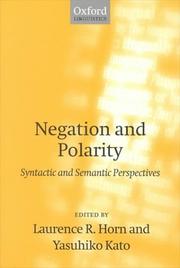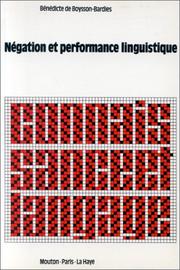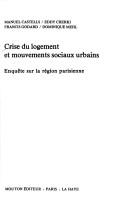| Listing 1 - 6 of 6 |
Sort by
|

ISBN: 3878083734 9783878083733 Year: 1987 Volume: 313 Publisher: Tübingen Narr
Abstract | Keywords | Export | Availability | Bookmark
 Loading...
Loading...Choose an application
- Reference Manager
- EndNote
- RefWorks (Direct export to RefWorks)
Linguistics --- Grammar --- Grammar, Comparative and general --- Language and logic --- Négations (Linguistique) --- Langage et logique --- Negatives --- Bibliography --- Bibliographie --- -Comparative grammar --- Grammar, Philosophical --- Grammar, Universal --- Language and languages --- Philosophical grammar --- Philology --- -Bibliography --- Grammar, Comparative --- Bibliography. --- -Negatives --- Négations (Linguistique) --- Comparative grammar --- Negatives&delete& --- Grammar, Comparative and general - Negatives - Bibliography
Book
ISBN: 9782875740533 2875740539 Year: 2013 Volume: 17 Publisher: Bruxelles : Peter Lang,
Abstract | Keywords | Export | Availability | Bookmark
 Loading...
Loading...Choose an application
- Reference Manager
- EndNote
- RefWorks (Direct export to RefWorks)
Français (langue) --- Linguistique --- Analyse du discours --- Contradictie --- Contradictieprincipe --- Contradiction --- Contradiction [Principe de ] --- Discourse analysis --- Discourse grammar --- Principe de contradiction --- Tekstgrammatica --- Tekstlinguïstiek --- Text analysis --- Text grammar --- Lexicology. Semantics --- Grammar --- Pragmatics --- Grammar, Comparative and general --- Language and languages --- Négations (Linguistique) --- Langage et langues --- Negatives --- Philosophy --- Philosophie --- Grammar [Comparative and general ] --- Linguistique.

ISBN: 0198238738 0198238746 9780198238737 Year: 2000 Publisher: Oxford New York : Oxford University Press,
Abstract | Keywords | Export | Availability | Bookmark
 Loading...
Loading...Choose an application
- Reference Manager
- EndNote
- RefWorks (Direct export to RefWorks)
Lexicology. Semantics --- Grammar --- Grammar, Comparative and general --- Polarity (Linguistics) --- Semantics. --- Négations (Linguistique) --- Polarité (Linguistique) --- Syntaxe --- Sémantique --- Negatives. --- Syntax. --- 801.56 --- Syntaxis. Semantiek --- 801.56 Syntaxis. Semantiek --- Polarity (Linguistics). --- Négations (Linguistique) --- Polarité (Linguistique) --- Sémantique --- Semantics --- Formal semantics --- Semasiology --- Semiology (Semantics) --- Comparative linguistics --- Information theory --- Language and languages --- Lexicology --- Meaning (Psychology) --- Polarity item (Linguistics) --- Linguistic analysis (Linguistics) --- Syntax --- Negatives (Grammar) --- Negatives --- Linguistics --- Philology --- Grammar, Comparative and general - Negatives. --- Grammar, Comparative and general - Syntax. --- Grammar, Comparative and general Syntax

ISBN: 2719304166 2713200261 9782719304167 Year: 1976 Volume: 4 Publisher: The Hague, Paris : Mouton,
Abstract | Keywords | Export | Availability | Bookmark
 Loading...
Loading...Choose an application
- Reference Manager
- EndNote
- RefWorks (Direct export to RefWorks)
Grammar --- Grammar, Comparative and general --- Psycholinguistics --- Children --- Négations (Linguistique) --- Psycholinguistique --- Enfants --- Negatives --- Language --- Langage --- -Psycholinguistics --- -801.56 --- Childhood --- Kids (Children) --- Pedology (Child study) --- Youngsters --- Age groups --- Families --- Life cycle, Human --- Language, Psychology of --- Language and languages --- Psychology of language --- Speech --- Linguistics --- Psychology --- Thought and thinking --- Comparative grammar --- Grammar, Philosophical --- Grammar, Universal --- Philosophical grammar --- Philology --- Syntaxis. Semantiek --- Psychological aspects --- Grammar, Comparative --- Psycholinguistics. --- Language. --- Negatives. --- 801.56 Syntaxis. Semantiek --- Négations (Linguistique) --- 801.56 --- Negatives (Grammar) --- Language development in children --- Interpersonal communication in children --- Vocabulary --- Grammar, Comparative and general - Negatives --- Children - Language --- SYNTAXE --- NEGATION

ISBN: 2719304468 2713200644 9782713200649 9782719304464 Year: 1976 Volume: 5 Publisher: Paris-La Haye : Paris : Mouton, L'Edition d'art,
Abstract | Keywords | Export | Availability | Bookmark
 Loading...
Loading...Choose an application
- Reference Manager
- EndNote
- RefWorks (Direct export to RefWorks)
Grammar, Comparative and general --- Psycholinguistics --- Négations (Linguistique) --- Psycholinguistique --- Negatives --- -Psycholinguistics --- 801.56 --- Language, Psychology of --- Language and languages --- Psychology of language --- Speech --- Linguistics --- Psychology --- Thought and thinking --- Comparative grammar --- Grammar --- Grammar, Philosophical --- Grammar, Universal --- Philosophical grammar --- Philology --- Syntaxis. Semantiek --- Psychological aspects --- Grammar, Comparative --- Psycholinguistics. --- Negatives. --- 801.56 Syntaxis. Semantiek --- Lexicology. Semantics --- French language --- Négations (Linguistique) --- Negatives (Grammar) --- Logement --- --France --- --Paris --- --Housing --- Residential mobility --- Urban renewal --- Grammar, Comparative and general - Negatives --- Housing - France - Paris region --- Residential mobility - France - Paris region --- Urban renewal - France - Paris region --- France --- Paris --- Housing --- SYNTAXE --- KLIMA (E.) --- JACKENDOFF (R.) --- PSYCHOLINGUISTIQUE --- NEGATION
Book
ISBN: 9783110238600 3110238608 130696847X 3110238616 9783110238617 Year: 2011 Volume: 235 Publisher: Berlin : Walter de Gruyter,
Abstract | Keywords | Export | Availability | Bookmark
 Loading...
Loading...Choose an application
- Reference Manager
- EndNote
- RefWorks (Direct export to RefWorks)
Why do grammars change? The cycle of negation proposed by Jespersen is crucially linked to the status of items and phrases. The definition of criteria establishing when a polarity item becomes a negative element, and the identification of the role of phrases for the evolution of negation are the two objectives pursued by the contributions to this volume. The contributions look at the emergence of negative items, and their relation within a given sentence, with particular reference to English and French. The comparative perspective supports the documentation of the fine-grained steps that shed light on the factors that (i) determine change and those that (ii) accompany actuation, which are considered through a dialogue between functionalist and formalist approaches. By looking at the place of negation in the architecture of the sentence, they take up the debate as to the relevance of phrasal projections and consider the role of features. Focusing on the make-up of individual items makes it possible to re-conceptualise the Jespersen cycle as the apparent result of the documented evolution patterns of individual (series of) items. This novel perspective is solidly grounded on an extensive use of the complete, up to date bibliography, and will contribute to shape future research.
Grammar, Comparative and general --- Polarity (Linguistics) --- Semantics --- Negatives --- Syntax --- Semantics. --- Negatives. --- Syntax. --- Lexicology. Semantics --- Grammar --- 801.56 --- 801.56 Syntaxis. Semantiek --- Syntaxis. Semantiek --- Négations (Linguistique) --- Polarité (Linguistique) --- Syntaxe --- Sémantique --- Polarity item (Linguistics) --- Negatives (Grammar) --- Formal semantics --- Semasiology --- Semiology (Semantics) --- Comparative linguistics --- Information theory --- Language and languages --- Lexicology --- Meaning (Psychology) --- Linguistic analysis (Linguistics) --- Negation. --- Polarity (Linguistics). --- Sprachwandel. --- Négation (linguistique) --- Grammaire comparée --- Sémantique structurale --- Syntaxe. --- Sémantique. --- Linguistics --- Philology --- Grammar, Comparative and general - Negatives --- Grammar, Comparative and general - Syntax --- Grammar, Comparative and general Syntax --- Historical Linguistics. --- Jespersen Cycle. --- Language Change.
| Listing 1 - 6 of 6 |
Sort by
|

 Search
Search Feedback
Feedback About
About Help
Help News
News